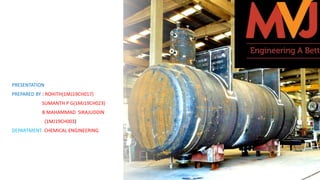
Heat Exchanger pdf.pptx
- 1. PRESENTATION PREPARED BY : ROHITH(1MJ19CH017) SUMANTH P G(1MJ19CH023) B MAHAMMAD SIRAJUDDIN (1MJ19CH003) DEPARTMENT: CHEMICAL ENGINEERING
- 2. CONTENTS: HEAT EXCHANGERS • Double pipe heat exchangers • Shell and tube heat exchangers • Advantages and disadvantages of heat exchangers
- 3. HEAT EXCHANGERS • Heat exchangers are use to transfer heat from one medium to another • These media may be gas , liquid or combination of both • The media may be separated by a solid wall to prevent mixing or may be in direct contact • In any process industry, we need to transfer heat for different operations (like cooling, heating, vaporizing, or condensing) to or from various fluid streams in various equipment like condensers, water heaters, re-boilers, air heating or cooling devices etc., where heat exchanges between the two fluids. • In a chemical process industry, the heat exchanger is frequently used for such applications. • Most heat exchangers have two streams, hot and cold, but some have more than two. • The inner wall of the small pipe is the heat transfer surface.
- 4. • Most heat exchangers have two streams, hot and cold, but some have more than two • Heat Exchanger is an adiabatic steady flow device in which two flowing fluids exchange or transfer heat between themselves due to a temperature difference without losing or gaining any heat from the ambient atmosphere. • Heat exchanger are commonly made up of aluminiun & copper both have thermal property and corrosion resistance
- 5. DOUBLE PIPE HEAT EXCHANGER • It is used when the heat transfer area required is relatively small. The double pipe heat exchanger recommends for use in small applications. They are utilized to transfer heat in small areas • It consists of concentric pipes, connecting tees, return heads and return bends. The packing glands support the inner pipe within the outer pipe. • They have most flexible designs , allowing for easy addition & removel of parts • even though they are able to used in parallel flow more often used in counter flow which restrict to some application
- 6. • This exchanger can be very easily assembled in any pipe fitting shop as it consists of standard parts and it provides inexpensive heat transfer surface. • In this exchanger, one of the fluids flows through the inside pipe and the other fluid flows through the annular space created between two concentric pipes either in co current or counter current fashion. • In is usually employed for decreasing the temperature of a hot fluid with the help of a cold fluid when flow rates are low. • There are commonly used in refrigeration services. • This heat exchanger may have one pipe or bundle of pipes (but lower than 30 pipes). The large pipe has lower than 200 mm in diameter. In some conditions, the inner pipe has vertical fins to improve the heat transfer coefficient between working fluids.
- 7. • Double pipe heat exchanger can handle high pressure & high temperature • hot fluid on the shell side exchanges or transfers sensible heat to the cold fluid • The double pipe heat exchanger is divided into multiple types on the basis of fluid flow. The double pipe heat exchanger has the following two major types: 1.Counter flow heat exchanger 2.Parallel flow heat exchanger
- 8. SHELL AND TUBE HEAT EXCHANGER Thermal design of a shell and tube heat exchanger typically includes the determination of heat transfer area, number of tubes, tube length and diameter, tube layout, number of shell and tube passes, type of heat exchanger (fixed tube sheet, removable tube bundle etc), tube pitch, number of baffles, its type and size, shell and tube side pressure drop etc. • Shell is the container for the shell fluid and the tube bundle is placed inside the shell. • Shell diameter should be selected in such a way to give a close fit of the tube bundle. • The clearance between the tube bundle and inner shell wall depends on the type of exchanger. • Shells are usually fabricated from standard steel pipe with satisfactory corrosion allowance.
- 9. • The most efficient condition for heat transfer is to have the maximum number of tubes in the shell to increase turbulence. • The tube thickness should be enough to withstand the internal pressure along with the adequate corrosion allowance. • The tube thickness is expressed in terms of BWG (Birmingham Wire Gauge) and true outside diameter (OD). • The tube length of 6, 8, 12, 16, 20 and 24 ft are preferably used. Longer tube reduces shell diameter at the expense of higher shell pressure drop. • Finned tubes are also used when fluid with low heat transfer coefficient flows in the shell side. • Stainless steel, admiralty brass, copper, bronze and alloys of copper-nickel are the commonly used tube materials.
- 10. The common types of shell and tube exchangers are i) Fixed tube-sheet exchanger ii) Removable tube bundle a. Floating-head exchanger b. U-tube exchanger
- 12. Disadvantage of DPHE Small heat transfer surface in a large floor space as compared to other types. Dismantling requires large time Maximum leakage points Advantage of DPHE Very attractive where heat transfer area required is small Simple in construction Cheap and easy to clean
- 13. Advantages of STHE •Relatively simple design and easy to maintain. •Cheap compared to plate heat exchangers. •Suitable for higher pressures and temperatures compared to plate heat exchangers. •Pressure drop is less than a plate heat exchanger. •Easy to find and isolate leaking tubes. •Easy to install sacrificial anodes. •Do not foul as easily as plate heat exchangers.
- 14. Disadvantages of STHE • Require more space to open and remove tubes. •Cooling capacity can not be increased, but a plate heat exchanger's can be. •Less efficient than plate heat exchangers.